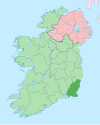|
Fethard-on-Sea
Fethard-on-Sea or Fethard (Irish: Fiodh Ard, meaning 'high wood')[2] is a village in southwest County Wexford, Ireland. It lies on the R734 road on the eastern side of the Hook peninsula, between Waterford Harbour and Bannow Bay. The village is in Fethard civil parish and partly in Fethard townland.[2] The village had a population of 311 as of the 2016 census.[1] It lies in the Fethard electoral district in the Wexford constituency. It is in the Templetown parish in the Roman Catholic Diocese of Ferns. Its main industries are fishing and tourism.[citation needed] Public transportTwo Bus Éireann routes serve Fethard-on-Sea: route 370 to Waterford via New Ross and a Tuesday-only route 373 to Wexford via Wellingtonbridge.[3] HistoryIn the 12th century, Baginbun near Fethard was the site of Norman landings during the Norman invasion of Ireland.[4][5] The remains of Norman-era earthworks and fortifications may be seen at Baginbun Bay, south of Ingard Point.[6] A 12th-century castle was built by Raymond le Gros, which passed to the Bishop of Ferns and was used as an episcopal residence. There is little evidence of the castle today.[citation needed] Alexander Devereux, the 16th-century bishop of Ferns and Abbot of Dunbrody, is buried in St. Mogue's Church of Ireland church.[5] Fethard was granted a charter by James I,[5] and became a municipal borough, with the parliamentary borough of Fethard sending two members to the Irish House of Commons until its dissolution in 1801. The seats were in the control of the Marquess of Ely.[7] In 1798, a harbour,[5] was built and this was a landing site for French troops during the Irish Rebellion of 1798.[citation needed] The Royal National Lifeboat Institution opened Fethard Lifeboat Station in 1886. Nine of the volunteer crew were killed while trying to save the crew of a Norwegian ship that had run aground at South Keeragh Island on 20 February 1914. The survivors of both crews were marooned on the island for two nights before they could be rescued. The lifeboat station was then closed but reopened in 1996 as home to an inshore lifeboat.[8][9][10] Village nameLong known simply as "Fethard", the village became known as Fethard-on-Sea following events in 1914 when the lifeboat Helen Blake capsized. Nine of the lifeboat's fourteen-man crew were drowned during a service mission to the schooner Mexico off the Keeragh Islands.[11] There was an outpouring of sympathy for the village and charitable donations were posted from around the world. To avoid this post from being misdirected to Fethard, County Tipperary, the name of the Fethard in County Wexford was reputedly changed to better distinguish the two.[11] Local businessesThere are three public houses in the village, a grocery shop and a number of cafes, B&B and a hotel that was refurbished and reopened in 2019.[12] Local tourist attractions include Hook Head Lighthouse and Loftus Hall, further afield on the Hook Peninsula. Fethard-on-Sea boycottIn May 1957, Roman Catholic villagers ("incited by the local curate") boycotted Protestant-owned local businesses in response to the actions of a Protestant woman, Sheila Cloney, who had left her Catholic husband and the village, to avoid being obliged to send her children to the local Catholic school.[13] The boycott received national and international attention before it concluded.[13] The family was reconciled, with the daughters being home-schooled.[14][15][16] A film was made about the Cloney family and boycott. Released in 1999, A Love Divided starred Orla Brady and Liam Cunningham.[17][18] A review of the film by the American Catholic League organisation questioned the film's depiction of the Catholic Church in Ireland.[19] Notable people
See alsoReferences
|
||||||||||||||||||||||


